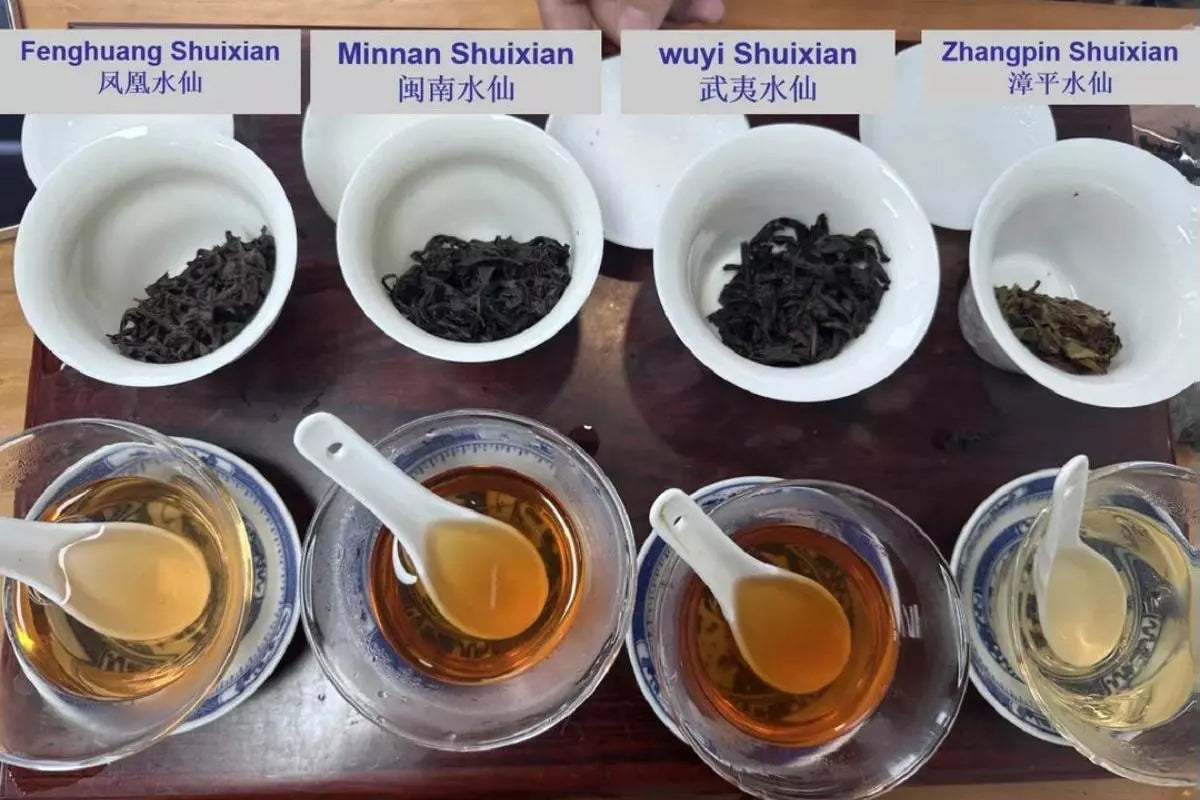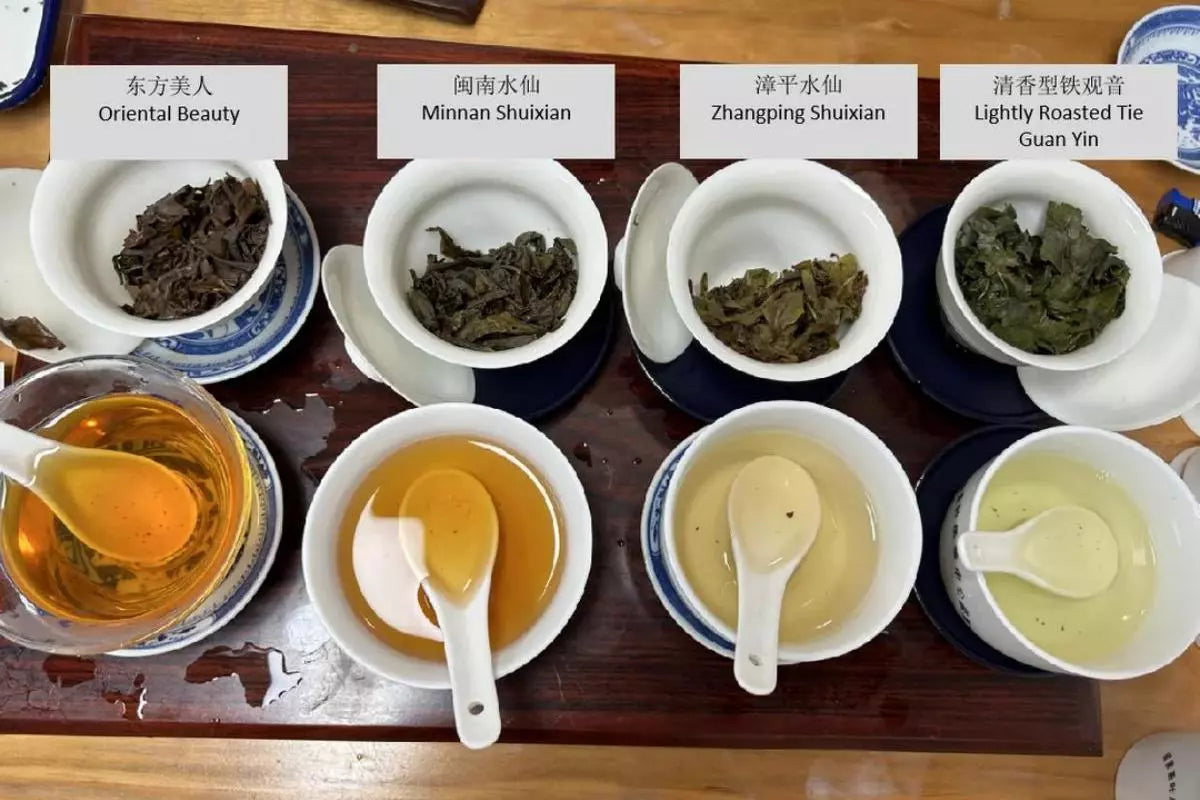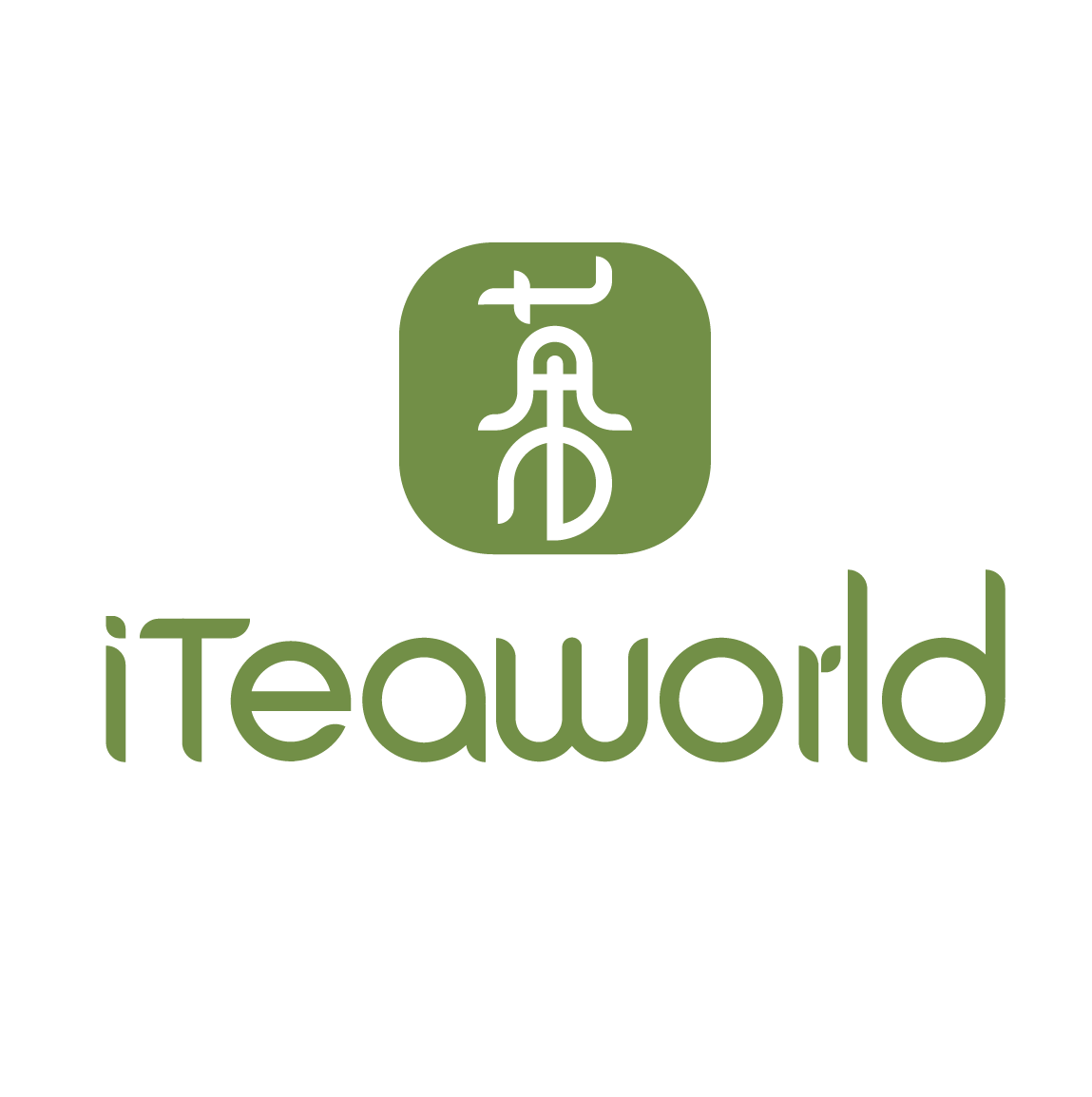Oolong Tea

Oolong Tea
Exploring Wuyi Yancha: The King of Oolong Teas
on Feb 17 2025
If you’re a tea enthusiast, you’ve likely encountered the unique flavors of oolong tea. But there’s one category that stands out among the rest: Wuyi Yancha. Revered as the "king of oolongs," Wuyi Yancha is a treasure from the Wuyi Mountains, located in China’s Fujian province. Known for its distinct “rock charm” or yan yun, this tea is cultivated in the rich, mineral-laden soil of the Wuyi Mountains Nature Reserve. The result? A tea with deep, complex flavors and a history that spans centuries.
Among the myriad varieties of Wuyi Yancha, Da Hong Pao, Wuyi Shuixian (Water Sprite), and Wuyi Rougui (Cinnamon) are some of the most famous. Today, let’s leave Da Hong Pao aside and dive into the other two—Shuixian and Rougui—which represent the foundation of this exquisite tea category.
1. Appearance of Dry Leaves
Wuyi Shuixian: This tea is made from a small tree species with notably large leaves. The older the tree, the higher the tea quality, and the leaves are typically harvested using a method known as "open face picking." This technique involves plucking 3–4 leaves while leaving the bud intact. The result is larger, thicker leaves that are also more tender than Rougui. These leaves create a unique texture and flavor that is prized by tea lovers, and it’s exactly what you’ll find in iTeaworld’s Wuyi Shuixian. This exceptional tea captures the essence of its heritage and craftsmanship, offering a taste of the true Wuyi Mountains.
Wuyi Rougui: Rougui comes from a shrub variety with smaller, oval-shaped leaves. The harvesting technique usually involves picking fully mature leaves, resulting in a more mature, compact leaf compared to Shuixian. These leaves offer a more robust and intense flavor, which is one of the reasons Rougui has earned its reputation for boldness and complexity.
2. Aroma of Dry Leaves
While the two teas share similar processing techniques—around 60%-70% oxidation and varying degrees of roasting—their dry aromas are often hard to distinguish. Both teas exude that signature Wuyi fragrance, but the roast level can shift the aroma slightly. If you’re exploring the world of Wuyi Yancha, whether you're sampling Wuyi Shuixian or Wuyi Rougui from iTeaworld, you’ll notice subtle differences in their fragrances that enhance your brewing experience.
3. Brewing Method
When brewing Wuyi Yancha, I prefer using a classic white porcelain gaiwan with boiling water (100°C / 212°F). Here's my go-to method:
First, give the tea a quick rinse to awaken the leaves.
For the second infusion, steep for 8–10 seconds to capture the tea’s core flavors. Wuyi Yancha, like iTeaworld’s Wuyi Rougui, should not be steeped too long—oversteeping can make it bitter.
For infusions 3–5, steep for about 15 seconds, and for infusions 6–10, extend the steeping time to 20–30 seconds. Wuyi Yancha, especially Wuyi Shuixian, is incredibly resilient and can handle multiple infusions while maintaining its rich, nuanced flavor.
4. Flavor Profile
In China, teas are often likened to personalities, and Wuyi Yancha is no exception. The two teas we’re discussing—Shuixian and Rougui—each bring something unique to the table:
Wuyi Rougui: Bold, intense, and spicy, Rougui is often compared to a strong, masculine energy. Its flavor profile includes a sharp, stimulating spiciness that lingers on the palate, accompanied by a subtle sweetness in the aftertaste. It’s the perfect choice for those who enjoy a bold and fiery tea. In fact, iTeaworld’s Wuyi Rougui has been crafted to deliver just that—a tea that both excites and soothes in every sip.
Wuyi Shuixian: On the other hand, Shuixian offers a smoother, more mellow experience. Often described as having a gentle, feminine charm, the tea features a delicate balance of floral and woody notes that linger softly on the palate. It’s calming, easy to sip, and perfect for a relaxing tea session. iTeaworld’s Wuyi Shuixian embodies this smooth, elegant flavor profile, making it a go-to choice for tea drinkers seeking a subtle yet deeply satisfying cup.
The flavor differences between these two teas can be attributed not only to the plant variety but also to the way they’re processed:
Shuixian is gently shaken five times during oxidation, each time with 600 rotations.
Rougui, however, undergoes a more intense shaking process—6–8 rounds of shaking, with each round increasing the number of rotations. This more robust processing brings out Rougui’s deeper, spicier flavors, making it a tea that packs more punch.
My Preference
Personally, I lean towards Wuyi Shuixian. Its smooth, lingering aroma and refined taste create the perfect atmosphere for a relaxed tea session. On the other hand, the boldness and spice of Rougui can be a little too stimulating for me at times. However, I can understand why some people prefer the strong, invigorating kick that Rougui offers.
But what about you? Do you gravitate towards the gentle, enduring fragrance of Shuixian, or do you love the strong, spicy kick of Rougui? If you haven’t yet tried iTeaworld’s Wuyi Shuixian or Wuyi Rougui, I highly recommend giving them a try. These teas offer a perfect introduction to the world of Wuyi Yancha and showcase the exceptional craftsmanship that goes into every batch.

Oolong Tea
Tieguanyin: Unveiling the Three Types of Exquisite Oolong Tea
on Feb 14 2025
Have you ever wondered what makes Tieguanyin tea so special? Perhaps you’ve tasted its smooth, floral flavor, but did you know there are different types of Tieguanyin tea, each with its own story, aroma, and flavor profile? From Light Aroma to Aged Aroma, Tieguanyin offers a world of variety that is as captivating as the tea itself.
The Origins of Tieguanyin
Tieguanyin, also known as Iron Goddess of Mercy, originates from Anxi County in Fujian Province, China. This iconic oolong tea combines centuries of tradition with meticulous craftsmanship. Its name reflects both its elegant flavor and the legend of compassion that surrounds its discovery. Today, Tieguanyin is celebrated worldwide for its exquisite taste and cultural significance.
Now, Anxi Tieguanyin is protected as a product of the original geographical indication. According to the national standards, Anxi Tieguanyin is produced within the administrative region under the jurisdiction of Anxi County, Fujian Province.
Under the natural ecological conditions within Anxi County, fresh leaves are selected from the Tieguanyin tea tree variety (yes, Tieguanyin is the name of the tea tree variety) for propagation by cuttings, cultivation and picking, and then processed through a unique traditional technique. It is an oolong tea with the characteristic features and quality of the Tieguanyin variety. The finished tea is classified into the light fragrance type and the strong fragrance type.
Types of Tieguanyin Tea
1. Light Aroma Tieguanyin (Qing Xiang)
Light Aroma Tieguanyin comes in two main variations:
Modern Light Aroma: With very low oxidation, this version emphasizes a fresh, orchid-like floral fragrance. Its inspiration comes from Taiwanese oolong tea, appealing to younger drinkers who love vibrant and aromatic teas.
Traditional Zheng Wei Tieguanyin: Known as the "authentic" Anxi-style Tieguanyin, it undergoes light roasting. This method creates a balanced tea where floral notes harmonize with a rich, satisfying body.
How to choose? If you adore bright, floral fragrances and have a healthy stomach, modern Light Aroma is ideal. For a more rounded experience, Traditional Zheng Wei is better—it’s aromatic yet gentle on the stomach.
2. Strong Aroma Tieguanyin (Nong Xiang)
This traditional style has medium oxidation and roasting, creating a tea with a toasty, malty fragrance and a robust flavor. Historically, this method allowed Tieguanyin to withstand long journeys when exported. Strong Aroma Tieguanyin is perfect for those who enjoy depth and complexity in their tea.
3. Aged Aroma Tieguanyin (Chen Xiang)
Aged Tieguanyin undergoes years of aging and controlled roasting, developing a smoother, mellower taste. Over time, its character evolves into something truly special. This version is perfect for those with sensitive stomachs or anyone who enjoys soothing, warming teas. Boiling aged Tieguanyin unlocks its deep, complex flavors. Generally, at least 10 years of aging is required to achieve its signature taste.
How to Identify Different Tieguanyin Types
Light Aroma: Bright green dry leaves with minimal oxidation. The tea soup is honey green in color, with a fresh, sweet and refreshing taste. The image is distinct, but the red edges on the leaves are not obvious.
Strong Aroma or Aged Aroma: Darker leaves, often brown or charcoal-colored, indicating higher oxidation and roasting levels.The aroma is rich and floral. The tea soup is golden yellow in color, with a thick, smooth and refreshing taste. The leaves at the bottom of the cup are soft, bright and have red edges.
When buying Tieguanyin, take note of the leaves’ color and aroma. Each style offers a distinct tea experience, so choose based on your flavor preferences.
The Magic of Tieguanyin
Tieguanyin isn’t just a tea—it’s an experience. With every sip, you’re tasting the dedication and skill of tea masters who have perfected their craft over generations. Whether you prefer the fresh florals of Light Aroma, the comforting depth of Strong Aroma, or the mellow smoothness of Aged Aroma, there’s a Tieguanyin for everyone.
Explore Tieguanyin with Iteaworld
For a premium Tieguanyin experience, explore the carefully curated selection at Iteaworld. Our teas are sourced from the finest tea gardens in Anxi and beyond, ensuring authentic flavors and exceptional quality. Whether you’re a seasoned tea lover or just beginning your journey into the world of oolong tea, Iteaworld offers the perfect Tieguanyin to suit your taste.
A Journey Worth Taking
Discovering Tieguanyin tea is like embarking on a journey through tradition, flavor, and artistry. Each cup tells a story of nature’s beauty and human dedication. Whether you’re sharing a pot with friends or enjoying a quiet moment alone, Tieguanyin brings warmth, peace, and joy to every occasion.

Oolong Tea
The Difference of Oolong Tea Taste Between Four Shui Xian Oolong Teas
on Feb 13 2025
Exploring the World of Shui Xian Oolong Tea
Shui Xian Oolong tea is a beloved tea variety that holds a prominent place in the world of Chinese teas. But with its many types and variations, it’s no surprise that people might wonder: What exactly makes Shui Xian oolong tea flavor so special?
In this post, we’ll explore the differences between four well-known Shui Xian Oolong teas from China’s Fujian and Guangdong regions: Phoenix Shui Xian from Guangdong, and Wuyi Shui Xian, Minnan Shui Xian, and Zhangping Shui Xian from Fujian. These four variants have distinct histories, flavors, and characteristics that set them apart, offering a wonderful range of experiences for tea lovers.
Phoenix Shui Xian: A Glimpse into Guangdong’s Rich Heritage
Phoenix Shui Xian originates from Fenghuang Town in Guangdong Province, an area famous for its unique approach to tea cultivation. The tea is made from seed-propagated local tea trees, initially cultivated from wild "Hong Yin" tea trees.
One of the standout features of Phoenix Shui Xian is its minimal oxidation process—unlike most oolong teas, which are oxidized to varying degrees, traditional Phoenix Shui Xian skips this process, making it closer to raw tea in style. This allows the tea to retain a fresh and fragrant aroma that reminds many of green tea, while still offering the complexity that oolong tea drinkers cherish.
In recent years, modern production methods may not strictly follow the traditional non-oxidized style, but the tea still retains its distinctive flavor. Phoenix Shui Xian is known for its fruity and floral notes, with a refreshing aftertaste that lingers on the palate.
Zhangping Shui Xian: Lightly Roasted with Delicate Floral Notes
Zhangping Shui Xian is another popular variety of Shui Xian tea, but it comes from the Fujian region, specifically Zhangping. This variety is known for being lightly to medium roasted, with oxidation levels slightly higher than that of floral-style Tie Guan Yin.
What makes Zhangping Shui Xian so unique is its distinctive packaging and processing method—it is often wrapped in paper and roasted, which gives it an elegant floral aroma reminiscent of orchids and gardenias.
The flavor profile of Zhangping Shui Xian is delicate and smooth, with a clean, sweet taste that is perfect for those who enjoy lighter oolong teas. Its subtlety and balance make it an ideal choice for those new to Shui Xian or those who appreciate a gentler oolong experience.
Minnan Shui Xian: A Fusion of Wuyi and Lighter Processing
Minnan Shui Xian, as the name suggests, hails from the Minnan region of Fujian Province, an area known for its tea craftsmanship. This variety was introduced from Wuyi Mountain and is processed using Wuyi-style techniques. However, Minnan Shui Xian undergoes lighter fermentation and roasting, making it distinct from the heavier, more robust Wuyi Rock Teas.
This tea offers a rich, smooth texture with subtle woody and floral aromas. While it doesn’t possess the intense fragrance of some other Shui Xian varieties, it provides a fuller, more robust liquor with a deep, satisfying taste. It’s a great option for those who enjoy a well-balanced, rich tea that isn’t overly floral or aromatic.
Wuyi Shui Xian: The Star of Wuyi Rock Tea
Wuyi Shui Xian is arguably the most famous and sought-after of all Shui Xian teas. Hailing from the prestigious Wuyi Mountains in Fujian, this tea is a prime example of the famed Wuyi Rock Tea (Yan Cha) category. It is known for its heavier oxidation and roasting, which result in a deep, complex flavor profile that features rich, baked sweet potato and ripe fruit notes.
The tea is full-bodied, smooth, and thick, with a remarkable balance between the roasted notes and the natural flavors of the tea. It is a great option for those who appreciate a robust tea with a distinct minerality, often described as "rock flavor" or "Yan Yun" in tea circles.
How to Choose the Right Shui Xian Tea
When choosing the right Shui Xian tea, consider your preferences and the type of tea experience you want:
If you love light floral teas, Zhangping Shui Xian is a must-try. Its delicate aroma and smooth texture make it a top pick, especially if you’re already a fan of lightly oxidized Tie Guan Yin.
For those who enjoy rich, roasted flavors, Wuyi Shui Xian is the clear winner. This variety showcases the exceptional craftsmanship of Wuyi Rock Tea processing, with a harmonious depth of flavor and aroma.
If you’re looking to explore the most floral and aromatic oolong teas, Phoenix Dan Cong is the way to go. This exceptional tea comes from the Phoenix Shui Xian varietal, a local group of tea trees that have been vegetatively propagated into elite single-bush selections. Each tea bush produces its own unique natural aroma, offering a wide range of flavor experiences.
Conclusion: A Tea for Every Taste
Choosing a Shui Xian tea can be a delightful journey, as each type offers something unique to the tea connoisseur. Whether you’re seeking the delicate floral notes of Zhangping Shui Xian or the deep, roasted flavors of Wuyi Shui Xian, there’s a Shui Xian variety for every preference. As you explore these different teas, remember that the world of Shui Xian is as diverse as the regions it comes from.
Trust in Quality, Trust in Iteaworld
If you’re looking to experience the best of Shui Xian tea, Iteaworld offers premium selections that showcase the craftsmanship and dedication of Chinese tea makers. Our Shui Xian Oolong teas are carefully curated to provide the perfect balance of flavor, aroma, and authenticity. Whether you’re a long-time tea enthusiast or a newcomer to Oolong, Iteaworld’s collection promises an unforgettable experience with every cup.

Oolong Tea
How to Truly Understand Oolong Tea? — Decoding the Flavor Profile of Oolong Tea
on Feb 05 2025
Oolong tea comes in many varieties, but the key factors that influence its flavor and aroma are: different oxidation levels, roasting degrees, tree ages, altitudes, seasons, and soil environments. To help you navigate the complex world of Oolong tea, we’ve created 6 different sample sets that highlight these factors. These sets are designed to help you discover the flavor rules of Oolong tea, making it easier to find the taste that suits your preferences. We hope these products will help more people make informed choices when buying Oolong tea.

Oolong Tea
Lightly Oxidized or Heavily Oxidized Oolong tea: How to Choose?
on Jan 27 2025
When people talk about Oolong tea, the first thing that often comes up is the roast level. Lightly roasted Tie Guan Yin, medium roast Phoenix Dancong, and heavily roasted Wuyi Rock teas like Da Hong Pao or Wuyi Rougui are the main varieties. Generally, the higher the roast, the higher the oxidation, so oxidation and roasting levels go hand in hand. Here's what I’ve learned about the impact of these factors:
Oxidation primarily influences the aroma and the freshness of the tea’s flavor. Light oxidation gives you a fresh, floral fragrance, while heavy oxidation brings a more mature and intense nutty or honey-like scent.
Roasting affects the lasting power of the aroma and the depth of the flavor in the tea. Light roast keeps the fresh fragrance intact, while heavier roasting gives the tea a richer, fuller taste, with hints of toasted or even charcoal flavors.
Oxidation mainly determines the flavor profile and the type of fragrance, while roasting adjusts the depth of the taste, the persistence of the aroma, and the color of the liquor.
I picked a few teas to compare: a lightly roasted Tie Guan Yin, Zhangping Shuixian, Minnan Shuixian, and Oriental Beauty. These four all come from Fujian, with roughly similar roast levels (all lightly roasted), but different oxidation levels. One thing I didn’t factor in is that the tea cultivar and other processes might not be exactly the same.
Here are the oxidation levels:
Tie Guan Yin: Light oxidation (10-20%)
Zhangping Shuixian: Mild-light oxidation (25-30%)
Minnan Shuixian: Medium oxidation (40-50%)
Oriental Beauty: Heavy oxidation (60-70%)
These four types of Oolong tea, with varying oxidation levels, are part of our Oolong Tea Oxidation Degree Collection. If you’d like to explore the different factors that influence the quality of Oolong tea, we welcome you to purchase and experience them yourself.
Roast levels:
Tie Guan Yin: Very light roast, 70-80°C (158-176°F)
Zhangping Shuixian: Very light roast, 70-80°C (158-176°F)
Minnan Shuixian: Very light roast, 80-90°C (176-194°F)
Oriental Beauty: Very light roast, 70-80°C (158-176°F)
The lightly roasted Tie Guan Yin and Zhangping Shuixian are easy to find, but it's much harder to find lightly roasted Minnan Shuixian because it’s typically processed using a method more similar to Wuyi Rock tea, which focuses more on roasting. (By the way, Tie Guan Yin, Zhangping Shuixian, and Minnan Shuixian also have medium roast versions, so if you’re interested, you could try those as well.)
The lightly roasted Oolong teas bring out purer, more distinct aromas, and are perfect for tea lovers who prefer clean, high-flying fragrances.
Now, what exactly does the difference in oxidation do to the tea?
Brewing:
Use a gaiwan with 100°C (212°F) water. Use 5g of tea with 100ml of water, steep for 10-15 seconds for the first 1-3 brews. (Since Zhangping Shuixian is compressed into blocks, the first brew needs to be 15 seconds, but after that, the steeping time can be the same as the other teas.)
Liquor and Leaves:
Teas with different oxidation levels are actually pretty easy to tell apart, much like green and black tea. Green tea isn’t oxidized, while black tea is fully oxidized. Lightly oxidized Oolongs, like Tie Guan Yin and Yongchun Buddha’s Hand, still have a thicker, smoother mouthfeel than green tea and their aromas are more intense. As oxidation increases, the tea’s color turns more orange-red, and the leaves shift from green to reddish-brown.
Aroma and Taste:
Lightly Roasted Tie Guan Yin:
The floral orchid scent is very noticeable—whether in the air or in the cup. What’s important is that it’s not bitter or astringent at all. I believe anyone who enjoys green tea would love to try lightly oxidized Oolong tea.
Zhangping Shuixian:
On its own, you can really get the scent of orchid and osmanthus—floral but with a slightly sweeter touch. The liquor is smoother than Tie Guan Yin, and the water feels sweet without any grassy taste. However, when compared to Tie Guan Yin, the floral fragrance isn’t as strong or distinct. I think this is why Tie Guan Yin is so popular, while Zhangping Shuixian is less appreciated. But if you like a more balanced, sweet floral Oolong, you should definitely give it a try.
Minnan Shuixian:
This lightly roasted Minnan Shuixian is actually made from raw tea of the Minnan Shuixian cultivar, which is actually a variety of Minnan Bei Shuixian (Northern Minnan Shuixian). It was dried at a low temperature without undergoing the roasting process. This is my first time trying it, and the flavor is intense, with a noticeable roasted nut aroma, but it also has a slight astringency because it wasn’t roasted. Overall, the flavor is more complex. Since it wasn’t roasted at high temperatures, there’s no smoky flavor in the tea. I’ve tried many Minnan Shuixian teas before, and the roasting process in those teas didn’t integrate as well as in Wuyi Rock tea, but this unroasted version is surprisingly clean and clear. My female friends particularly enjoy this pure, layered taste.
Oriental Beauty:
This version of Oriental Beauty is made from tea leaves from Sanming in Fujian, not Guangxi. The Taiwanese versions are more expensive. Because of its high oxidation and light roasting, it’s very close to black tea, but it has a smooth silkiness and a refreshing taste that black tea lacks. It’s sweet with no sourness or bitterness, and has an elusive fragrance that’s hard to pinpoint. This is a unique flavor that red teas can’t quite match. If you enjoy delicate, fragrant red teas, you should definitely give Oriental Beauty a try. It truly lives up to its name—an elegant, understated beauty from the East, with depth and charm.
Like me, my friends love these four Oolong teas with different oxidation levels and light roasting. They each have their own style, and it really shows how oxidation determines the flavor profile and aroma of the tea.


